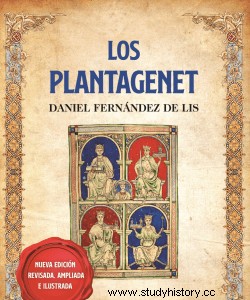
In some blog post we have talked about the war that with the name of war of the Roses faced in England the houses of York and Lancaster in the fifteenth century. After the Battle of Tekesbury in 1471, the House of York managed to prevail over its rival and definitively place the crown on its pretender to the throne:Edward IV.
Eduardo had married the widow Isabel Woodville, who gave him ten children; Among them were the heir to the throne Eduardo, his brother Ricardo and our protagonist Isabel. The line of succession seemed assured and the disputes between the possible contenders for the crown, definitively settled.
However, the death of Edward IV in 1483 triggered one of the most convulsive and controversial periods in the history of England. The heir to the throne, Edward V, was a minor and the king's will named the Duke of Gloucester, Richard, brother of the late monarch, regent. From there, events rush:Ricardo goes to meet the entourage that takes the future Edward V to London to be crowned and once in the capital installs the heir in the Tower of London; for her part, the widowed queen Elizabeth Woodville takes refuge in Westminster Abbey where she takes refuge with the rest of her sons and daughters, although later she allows her second son to settle with his brother in the Tower of London.
It is then that two events take place that still arouse enormous controversy today and about which rivers of ink continue to flow:
– On the one hand, Parliament passes a decree (the so-called Titulus regius) by which it is declared that Eduardo IV had contracted marriage prior to his union with Isabel Woodville and therefore this marriage is null and all the descendants of the couple, illegitimate; consequently, Richard Duke of Gloucester is proclaimed king under the name of Richard III.
– On the other hand, the two sons of Edward IV who were housed (not captives) in the Tower of London (which was then a royal residence and not a prison) mysteriously disappear never to be heard from again. To this day it remains a mystery what happened to the "princes of the Tower", or rather who was responsible for their death (because it seems clear that they were murdered).
The figure of Richard III is probably the most controversial in the history of England and to this day continues to generate a heated debate; He was not only accused of murdering the princes of the Tower, but also of wanting to marry their sister, his niece and our protagonist Elizabeth of York.
Be that as it may, the truth is that Ricardo's movements to access power earned him the enmity of a good part of his subjects and very specifically of two powerful factions of the English nobility:the Woodvilles who had dispossessed of their succession rights, and the embers of the defeated faction of the Lancasters, led by Margaret Beaufort and her son, exiled in France, Henry Tudor.
Isabel Woodville and Margaret Beaufort joined forces to overthrow Ricardo and as part of their agreements they agreed to marry the daughter of the first and Edward IV, Isabel, and the son of the second, Enrique, who returned from his exile in France to defeat Richard III in 1485 at the Battle of Bosworth. Henry Tudor took possession of the crown, inaugurating the reign of this dynasty with the name of Henry VII.
In 1486 the marriage between Elizabeth of York and Henry Tudor was consummated. Thus, the blood of the Plantagenet dynasty and the House of York, inherited by Elizabeth from her father Edward IV, converge with that of the House of Lancaster and the Tudor family, inherited by Henry VII from his parents Margaret Beaufort and Edmund Tudor. Anyone who wants to know more about the origin of the Tudor dynasty can read the article that we dedicate on the blog to Catherine of Valois.
Two sons were born from the marriage between Henry VII and Elizabeth of York:Arthur and Henry (the future Henry VIII). Arturo died before being able to inherit the crown from his father, but before he died he married the daughter of the Catholic Monarchs, Catherine of Aragon. After Arthur's death, Catherine was given in marriage to her brother Henry VIII. The disagreements of this marriage and the influence on them of the marriage between Arturo and Catalina make for a fascinating story, but that's another story.
There are many works that deal with the historical period narrated in this entry. About the war of the Roses and a different vision of Richard III from the one given by Shakespeare, I recommend the series of novels that Sharon Kay Penman wrote with the title of "The War of the Roses". And about the mystery of the princes of the Tower, Josephine Tey's crime novel "The Daughter of Time" is very curious and interesting.
Image| Elizabeth of York
Dan Jones. Plantagenets, The Kings Who Made England .. Ed. William Collins, London. 1st edition (2103)
Peter Ackroyd. A History of England Volume I (Foundations) .Ed. Mcmillan, London. 1st edition (2011)
Roy Strong. The Story of Britain .Ed. Pimlico, London. 1st edition (1998)
Simon Schama. A History of Britain. BBC Worldwide Limited, London. 1st edition, fourth printing (2000)
Derek Wilson. The Plantagenets, The Kings That Made Britain . Quercus Edition Ltd., London. Ebook edition (2014)
Matthew Lewis. The Wars of the Roses:The Key Players in the Struggle for Supremacy . Amberley Publishing, Stroud. 1st edition (2015)
